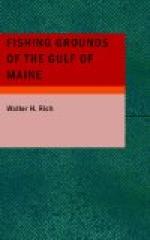Under this heading are listed those grounds of the innermost chain of shoals, ledges, and “fishing spots”, patches of rocky and gravelly bottom, the deeper water between them being over the muddy ground, which line the coast of the Gulf of Maine, making of it an almost continuous piece of fishing ground. In the Reports of the United States Bureau of Fisheries, on which all the statistics of the catch and value of the various species quoted in this report are based, these figures are grouped under the heading “Shore”.
The larger and more important of these grounds are outcroppings along the edge of the 50-fathom curve and lie at distances varying from 12 to 20 miles offshore; but there are many inside this line, and where the deep water of the Gulf of Maine extends so far inshore some are close in to the land. Thus, nearly all are within comparatively easy reach even for the smaller craft (where these all now have power) and so furnish productive fishing for a large fleet of gill netters and sloops (small craft of from 5 to 10 tons net) and to the myriad of “under-ton” boats (of less than 5 tons net), all these being enabled to run offshore, “make a set,” and return the same day.
With the uncertainties of the weather and the hazards of the winter fishing, very often the large vessels also follow this practice on those not too frequent “fish days” (when conditions permit fishing “outside “) that intervene between the storms; and with the scarcity of fish in the markets usual to the season and the consequent better price for the catch, with ordinary fishing luck they are well paid for doing so.
The fish of these shore grounds, due perhaps to the greater abundance of food here, are thought to be distinctly superior in quality to those of the same species taken on the offshore banks. The cod and the haddock, especially, of the Gulf of Maine are particularly well conditioned fish and are noted for their excellence.
The figures presented in Table 2 show only a fraction of the catch from the Inner Grounds, since they deal entirely with the fares of fishing vessels of 5 net tons and over. There are literally thousands of the so-called “licensed” or “under-tonned” boats, mainly gill-netters, that take millions of pounds from these waters annually, principally cod and haddock.
On the Maine coast and across the line in New Brunswick there are more than 300 weirs which furnished to American smokers and canners during the year 1923 (whose figures have been chosen as representing an average season) 77,000,000 pounds of herring. On the coast of Massachusetts there are 50 or more weirs and fish traps, and from the Isle of Shoals to Pemaquid Point in Maine there are more than 50 floating traps in the various bays, on the points of offshore islands, or even in the open sea, and all these take a rich harvest from these waters. Then, too, there is the lobster fishery, more important in the Gulf of Maine than anywhere else in the United States.




